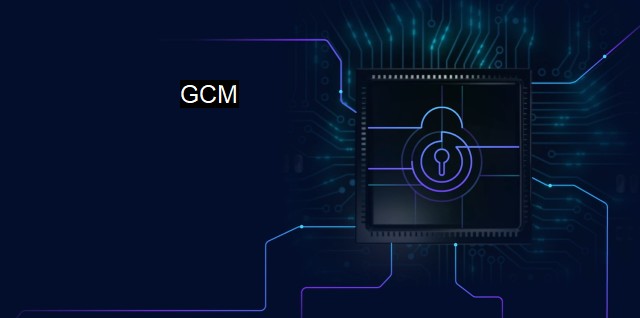What is GCM?
Exploring the Advantages of GCM (Galois/Counter Mode): A Robust Cryptographic Mode for Securing Data in Networks and Disks
The Gallium Cipher Mode (GCM) refers to a method of encrypting and authenticating data utilized in cybersecurity. In particular, this method is deployed in software and hardware where both confidentiality and integrity matter equally while also requiring improvements in performance.Though a significant part of cryptography, GCM is relatively recent. Its advent dates back to 2004, when it gained full approval by the National Institute of Standards and Technology (NIST) as an enhancement cipher for the already established Advanced Encryption Standard (AES).
At its base, GCM provides confidentiality by encrypting plaintext data into what is known as ciphertext, incapable of being understood nor processed. GCM follows basic symmetric encryption principles, requiring the same key during both the encryption and decryption stages of the process. The main benefit of symmetric encryption is its inherent speed, aligning perfectly with GCM's goals centered on performance improvements.
Along with confidentiality, GCM also bolsters message integrity via a mechanism known as “authentic encryption,” which mixes hashing and encryption functionalities. The authentication largely indicates that the sent data was not tampered with during transmission, conferring additional protection from data breaches. Markedly, without such authentication, cybercriminals could corrupt or change the plaintext prior to it being encrypted, thus compromising the data's credibility and violating integrity.
In operation, GCM relies on the encryption of a nonce, meaning a number only used once. Nonce is chosen with each encryption and, when paired with the secret key, renders repetition attacks useless. Their combination forms an initiation vector for each block of data, introducing a unique variation for every encryption. Any alteration in the received block sequence or attempted repetition causes the security protocol to abandon the decryption process, thus staying resilient against common forms of cyberattacks.
Hardware-wise, GCM offers relatively low latency, which is the time taken between the input entering the system and its output delivery. Despite its complexity, GCM can process large amounts of parallel-able data, providing developers with high-speed solutions suitable for demanding modern applications. Conversely, antivirus software often adopts GCM in their operations as it helps identify and block online attacks on systems even under immense server loads.
The reason GCM holds such a significant position in cybersecurity revolves around its superior speed, relative simplicity, and advanced performance capabilities, making it highly suitable for high-speed network systems. Recorded benchmarks indicate that GCM outperforms previous modes in the same context such as CBC (Cipher Block Chaining) and CTR (Counter Mode), primarily in hardware implementations.
In an antivirus setting, GCM facilitates safe operations and communications, particularly concerning updates and definition downloads, which are crucial for the software's functionality. They involve sensitive data that needs to remain both confidential and unaltered throughout the process, something that GCM authenticity encryption proactively helps to maintain.
GCM forms an essential cornerstone of modern encryption technology widely implemented specifically in areas requiring action in large volumes and higher speeds. The mechanism's innate skills for encryption and data integrity combined with its competitive performance levels make GCM a formidable tool against cyberattacks. The algorithm plays an indispensable role in ensuring that the digital world is secured against ever-evolving threats, further confirming cybersecurity's vital role in establishing a safer online community.

GCM FAQs
What is GCM mode in cryptography?
GCM (Galois/Counter Mode) is a standard mode of operation that provides both confidentiality and authenticity of data in cryptography. It is widely used in encryption algorithms, including AES (Advanced Encryption Standard). GCM mode uses a combination of counter and Galois field multiplication to provide cryptographic security.How is GCM mode different from other modes of operation?
Unlike other modes of operation, GCM combines encryption and authentication in a single step. This means that it can provide both confidentiality and authenticity of data in one go. Additionally, GCM is faster than other modes of operation due to its parallelizable nature.What are the advantages of using GCM mode in antivirus software?
GCM mode provides strong encryption and authentication capabilities that make it an ideal choice for antivirus software. With GCM, antivirus software can encrypt sensitive data while ensuring that it has not been tampered with. Additionally, GCM mode is faster than other modes of operation, which helps antivirus software scan large volumes of data faster.What are the potential security risks associated with using GCM mode?
While GCM mode provides strong encryption and authentication capabilities, it is still susceptible to attacks such as side-channel attacks and nonce reuse. These attacks can compromise the confidentiality and integrity of data encrypted using GCM mode. It is important to implement proper key management and nonce generation techniques to mitigate these risks when using GCM mode.| | A | | | B | | | C | | | D | | | E | | | F | | | G | | | H | | | I | | | J | | | K | | | L | | | M | |
| | N | | | O | | | P | | | Q | | | R | | | S | | | T | | | U | | | V | | | W | | | X | | | Y | | | Z | |
| | 1 | | | 2 | | | 3 | | | 4 | | | 7 | | | 8 | | |||||||